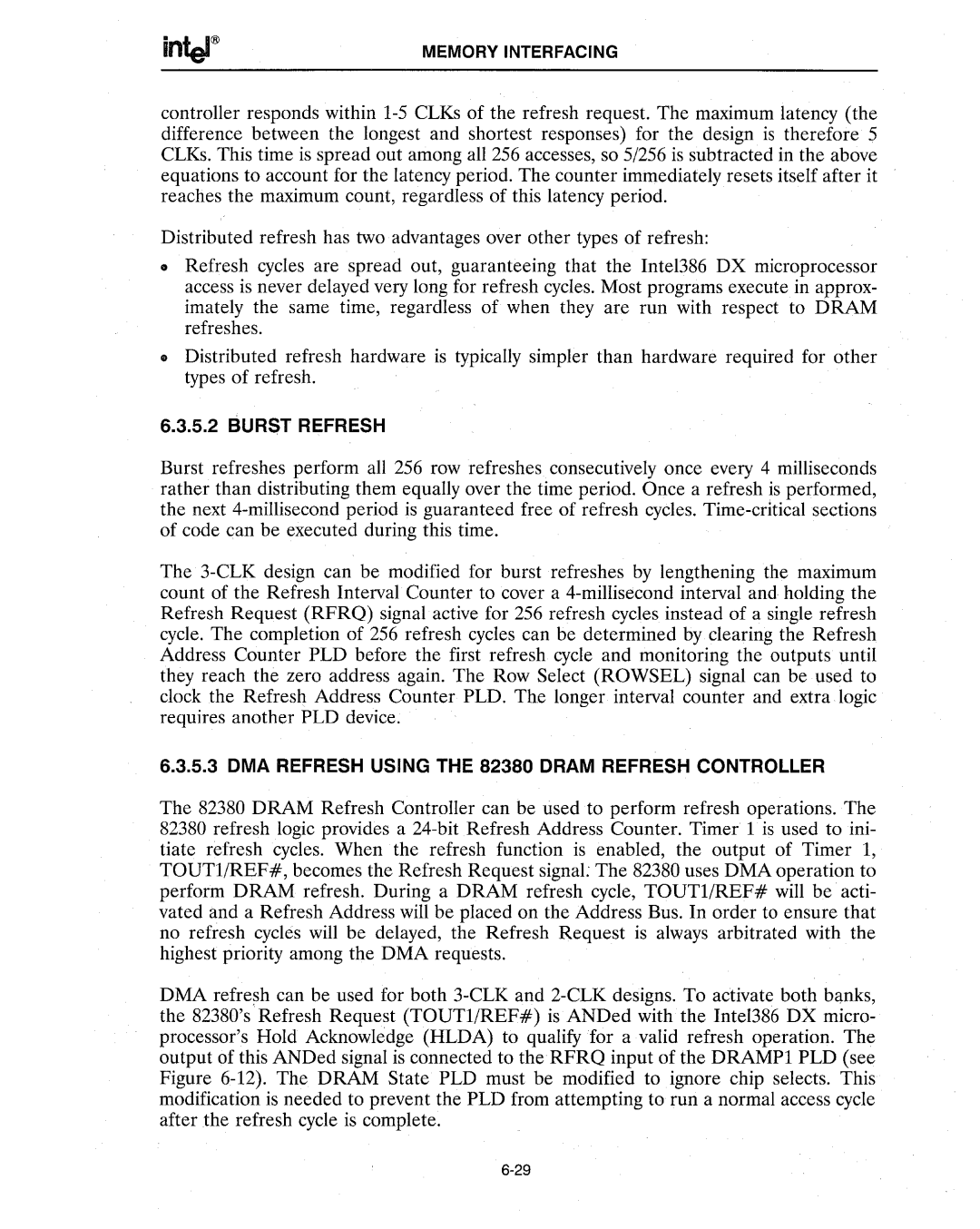MEMORY INTERFACING
controller responds within 1-5 CLKs of the refresh request. The maximum latency (the difference between the longest and shortest responses) for the design is therefore 5 CLKs. This time is spread out among all 256 accesses, so 5/256 is subtracted in the above equations to account for the latency period. The counter immediately resets itself after it reaches the maximum count, regardless of this latency period.
Distributed refresh has two advantages over other types of refresh:
•Refresh cycles are spread out, guaranteeing that the Inte1386 DX microprocessor access is never delayed very long for refresh cycles. Most programs execute in approx- imately the same time, regardless of when they are run with respect to DRAM refreshes.
•Distributed refresh hardware is typically simpler than hardware required for other types of refresh.
6.3.5.2BUR&T REFRESH
Burst refreshes perform all 256 row refreshes consecutively once every 4 milliseconds rather than distributing them equally over the time period. Once a refresh is performed, the next 4-millisecond period is guaranteed free of refresh cycles. Time-critical sections of code <.:an be executed during this time.
The 3-CLK design can be modified for burst refreshes by lengthening the maximum count of the Refresh Interval Counter to cover a 4-millisecond interval and holding the Refresh Request (RFRQ) signal active for 256 refresh cycles instead of a single refresh cycle. The completion of 256 refresh cycles can be determined by clearing the Refresh Address Counter PLD before the first refresh cycle and monitoring the outputs until they reach the zero address again. The Row Select (ROWSEL) signal can be used to clock the Refresh Address Counter PLD. The longer interval counter and extra logic requires another PLD device.
6.3.5.3 DMA REFRESH USING THE 82380 DRAM REFRESH CONTROLLER
The 82380 DRAM Refresh Controller can be used to perform refresh operations. The 82380 refresh logic provides a 24-bit Refresh Address Counter. Timer 1 is used to ini- tiate refresh cycles. When the refresh function is enabled, the output of Timer 1, TOUTl/REF#, becomes the Refresh Request signal: The 82380 uses DMA operation to perform DRAM refresh. During a DRAM refresh cycle, TOUTl/REF# will be acti- vated and a Refresh Address will be placed on the Address Bus. In order to ensure that no refresh cycles will be delayed, the Refresh Request is always arbitrated with the highest priority among the DMA requests.
DMA refresh can be used for both 3-CLK and 2-CLK designs. To activate both b&nks, the 82380's Refresh Request (TOUTl/REF#) is ANDed withthe Intel386 DX micro- processor's Hold Acknowledge (HLDA) to qualify for a valid refresh operation. The output of this ANDed signal is connected to theRFRQ input of the DRAMP1 PLD (see Figure 6-12). The DRAM State PLD must be modified to ignore chip selects. This modification is needed to prevent the PLD from attempting to run a normal access cycle after .the refresh cycle is complete.
6-29

